
Happenings at TiE Pune this month:
- Three women entrepreneurs tell their stories
- Darshan Doshi CM, shows how to ace your pitch
- Abhijeet Khandagle, TiE Nagpur CM, opens up the Govts schemes for start-ups
My Story Session with Three Women Entrepreneurs
On April 20th Ashwini Deshpande, our Charter Member spoke to three ladies whose businesses are now successful. They tell their stories. Read on…
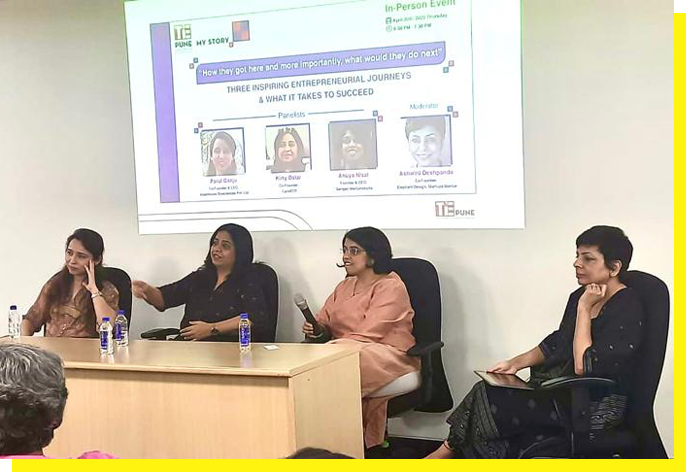
Making the Ubiquitous Sugarcane Juice Hygienic
No true Indian can ever say they never had sugarcane juice or don’t simply love the sweet, cool juice. But how many can get out there and get a glass without worrying about falling sick? Or with the omniscient presence of coffee (strangely) how is it that an authentic Indian drink is not easily available in India?
That is exactly what bothered Kirty Datar and her husband Milind who both gave up their corporate journey with one mission – to revive the consumption of sugarcane juice in our country. Their mission was to revive the dwindling culture of sugarcane juice consumption in India. At our My Story Session, Kirty talks about her journey and what it took to put their goal into action.
“Our vision was simple yet powerful: just as coffee chains like CCD or Starbucks had successfully made coffee aspirational, why couldn’t the same be done for sugarcane juice? With its status as India’s cultural drink and its immense potential for scalability, I believed that sugarcane juice could become a part of people’s everyday consumption habits, much like tea or coffee.
We began with a Semi-Automatic Kiosk Model in Corporate Cafeterias in Pune, serving fresh and hygienic sugarcane juice. As demand grew, we realized that fresh sugarcane juice made in hygienic conditions had the potential to become a regular part of people’s lives.
Challenges:
“Our biggest challenge was sourcing high-quality raw materials from farmers on a consistent basis. While farmers traditionally did not prioritize the quality of sugarcane when dealing in bulk, we had taken a research- based approach to define the specific requirements regarding variety, age, brix (sweetness level), and even the diameter of the cane. Overcoming this challenge involved extensive training, quality control, and building relationships with the farmers. By offering premium value for their produce and providing regular payments, we managed to motivate not only the farmers but also their younger generations who were previously uninterested in sugarcane farming. As a result, numerous farmers in the region eagerly approached us, willing to offer 100 times more produce than we originally sourced.
Being a Woman Entrepreneur:
“I think as a woman I am better equipped to deal with different kinds of people, understand their point of view and nurture relationships. My frequent visits to the farms and interactions with farmers and laborers have built trust and played a crucial role in our success.
Scalability:
While the demand and supply are thriving, Kirty and Milind realized that we overlooked a critical factor: scalability. Despite selling over 28 lakh glasses of sugarcane juice through a handful of corporate cafeteria kiosks, we were unable to grow beyond a certain point due to the limitations of our business model. The kiosks required a minimum of 100 sq.ft and three operators, making it difficult to expand. Unfortunately, our growth efforts were further hampered by the onset of the pandemic, which forced the closure of all our corporate kiosks and brought our revenue to a standstill.
Refusing to be undone by a virus, we decided to re-evaluate our business model. We thought why not have an automated system that could do the job? So, we developed CaneBOT, India’s first fresh sugarcane juice robot—a fully automated, self-ordering compact machine that occupies only 15 sq.ft of space and requires minimal operator intervention. Our innovation was granted a patent, and we built a frugal prototype while seeking funding for the Minimum Viable Product (MVP).
Although we did not secure funding through Shark Tank India Season 1, the experience taught us that approaching investors before having a ready MVP would be futile. So, we shifted their focus and secured government grants of 60 lakh rupees (with an additional 10 lakh rupees from our mentor) to build the MVP. Alongside financial support, we were fortunate to receive valuable mentoring from organizations such as TiE Pune and other accelerator programs, which helped refine our business model and prepare for scalability.
Re-entry to the Market:
We are ready. We now have a deep understanding of both the demand and supply sides, along with our technological innovation and scalable business model, we are extremely confident of our future prospects. CaneBOT has revolutionized the journey of sugarcane juice, from farm to glass, making a positive impact on the socio-economic fabric of rural farmers, consumer health, and the nation’s economy. This frugal innovation addresses the world’s largest sugarcane juice drinking market. With CaneBOT’s smart kiosks serving freshly crushed sugarcane juice 24×7, it is poised to become a globally scalable lifestyle beverage.
The Lesson:
One important lesson we have learned is that there is no such thing as success or failure; it’s all about navigating through highs and lows. As long as we remain agile enough to bounce back from setbacks, the highs will inevitably follow. Our unwavering determination, combined with the support of mentors, accelerator programs, and government grants, has propelled us forward. We are excited about the future as we continue to refine our business model, leveraging our tech innovation, and take CaneBOT to newer heights.
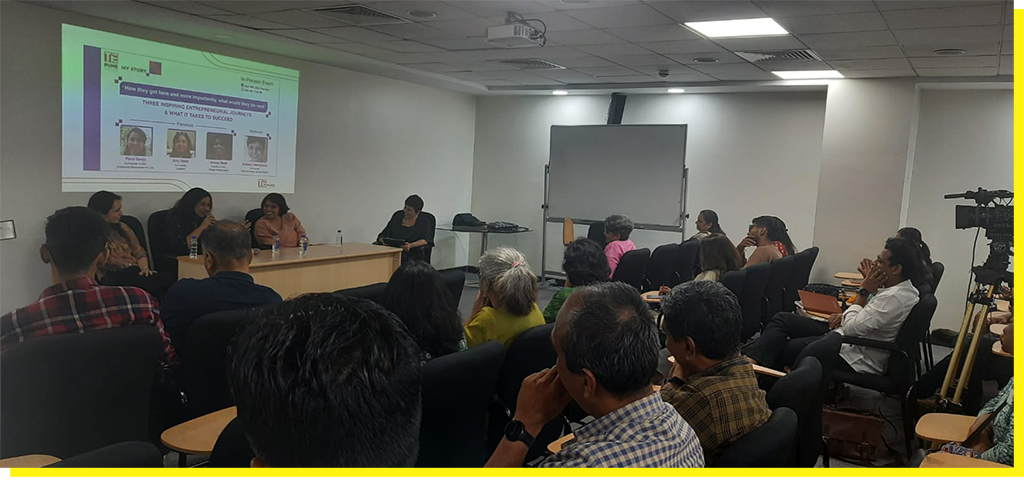
A Solution for a Much-Neglected Skin Disorder
Vitiligo affects approximately 1-2.5 % people in India. And fact is that allopathy has no real solution for this hypo-pigmentation skin condition which poses no health risk. And perhaps that is the reason it is not considered a serious problem?
However, ask a person who has those ‘white patches’ and you will know how much fear, self-imposed isolation, and social ostracization even they go through.
Dr Parul Ganju believed that there is no problem that has no solution. And her company Ahhamune is working on a solution that can help people with vitiligo get rid of those darned white patches.
Parul in her own words:
“While the idea for starting a drug discovery company was a risky one, the potential of the impact that the business would have on the society is what motivated me to take a plunge into entrepreneurship. Since then, I believe that hard work and perseverance is what has helped the company to grow and science to progress.
On Funding:
“However, drug discovery, as a field, has not been too appealing to Indian investors as it is capital intensive with long timelines. Finding the right set of people who believe in our vision and fund this cause was thus challenging. My own learning curve has been very steep during this time. But with the guidance of our mentors and the hard work of our passionate team, the company has been able to move past the obstacles and has reached the first major milestone in drug development with successful completion of Phase I trials.
Boney Tales:
In many cases accidents, infections or even cancer can cause large cavities in the bone. The gold standard for dealing with this is to use bone from another part of the body known as autografting. This means double surgery and that much more trauma for the patient.
But if you possess an innovator’s mind, then even a ‘gold standard’ in medical treatments will irk you. As it did for Anuya Nisal, who founded Serigen. Says she, “It is sad that people must undergo the trauma and stress of two surgeries and because the grafted bone is superior to synthetic materials like glass, ceramic etc, it’s widely used. As a result, India today imports more than 80% of the medical devices that are used in the healthcare sector.”
Anuya was obsessed with the thought of how this problem could be solved. “I wondered if natural polymers could work in such situations. Especially silk proteins. Add to that the fact that India is the second largest producer of silkworm silk globally. In fact, sericulture employs more than 8.6 million people in India.”
Anuya worked to develop a novel and innovative processing protocol that could convert silk threads into a solution that can then be structured and shaped into a variety of different forms. These forms can then be used to solve complex and challenging problems in the healthcare sector.
What the product does:
Serioss matches the performance of an autograft, while retaining the convenience of use of a synthetic bone void filler. It is available in different shapes, sizes and forms and the surgeon can choose depending on size and shape of cavity as well as the anatomical location of the defect.
“In lab and animal studies, we have shown an unprecedented 2X improvement in bone repair parameters compared to the best global alternatives, resulting in reduced repeat fractures. Serigen is the world’s first company to successfully complete a clinical trial for use of silk in bone repair. Our vision was to establish a bridge between these two sectors”
Challenges:
“In addition to the regular challenges faced by entrepreneurs, translating deep science innovations into products, we also had to develop a robust IP strategy, raise appropriate resources to support the long gestation time and build an interdisciplinary team.
“An innovator entrepreneur needs to have a great IP strategy, be able to raise appropriate resources to support longer gestation time that such products need and build an interdisciplinary team.
“Developing medical devices combines the principles of materials science and engineering with cell biology and biochemistry. It also requires you to understand and implement the regulatory framework (clinical trials, clean room manufacturing and quality standards).
“Thus, it needs people with expertise in varied domains but have the ability to efficiently communicate with each other
“We were able to overcome these challenges by raising significant amount of grant funds in the initial stages from various government agencies. We have also consciously worked on building a team that is passionate about translating innovative technologies into products.”
Now Where?
After becoming the first in the world to develop bone filler using silk protein we want to continue this journey where we discover newer and better uses of such natural polymers that can better replace medical devices.
“Becoming a clinical stage company comes with a huge opportunity as well as associated challenges. The team has worked closely together and cross-trained to overcome these challenges.
“Our goals are now focussed on advancing our drug pipeline further, with multiple clinical trials and fuelling the growth of other discovery programs to fulfill unmet medical needs in the dermatology arena. Our vision is to utilize our core small molecule platform to provide breakthrough treatments for patients throughout the world. These treatments have the potential to touch the lives of millions of people who are waiting for the cure of their chronic skin diseases.
Acing Your Start-Up Pitch
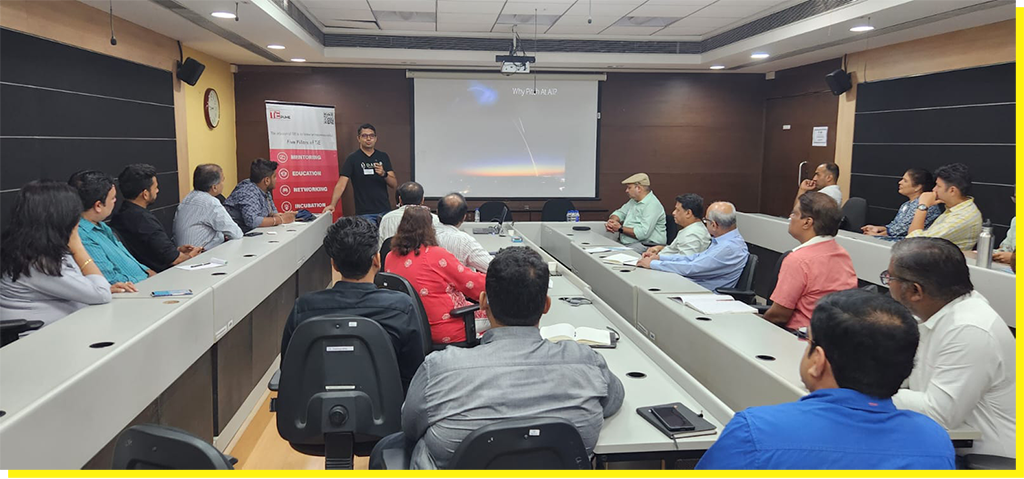
Darshan Doshi is our TiE Pune Charter Member who is passionate about start-ups and financial independence for all. At our Guru Gyan sessions Darshan gave some pointers on how to ace your start-up pitch
Every start-up needs money to do business, and there are many sources, most obvious ones being VCs. Angels, Banks and so on. However in my opinion the best way to fund your business is with your customers’ money. And since that is not always so, we need to pitch before people who can help us with funds.
“But let’s start at the beginning. Why should you pitch? It’s to tell your story, to sell your idea. So, if you are looking to raise funds you are selling to get funds. If you want people to buy your product or service then it’s a customer you are addressing or it could be to employees, vendors, partners, the ecosystem and so on.
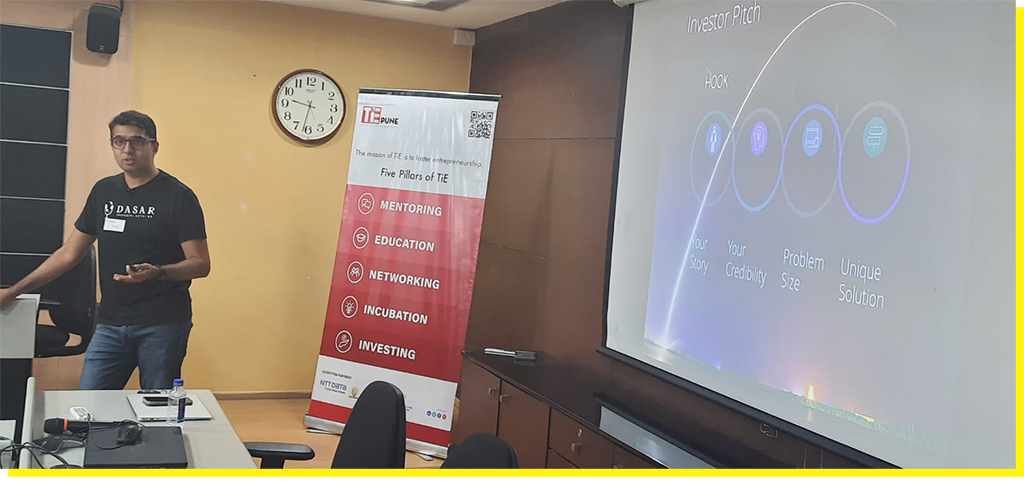
Pitch Formats:
- The first thing is credibility. Why are you the person who should pitch? Are you authentic? Is your story real?
- Time: nothing can be worse than a pitch that crosses its time limit. If you meet a VC in the elevator, can you tell him your story in 30 seconds? You should have different pitches ready – 30 sec one, a pitch that can be 30 seconds, 60 seconds. Everyone can tell their story in 20 mins but that is for the seed investor. A pitch is to get the VC interested enough to call for another meeting.
Your body movements, language all matter. If you are to meet your local banker or customers, know the local language. It makes a difference.
Elements of a great Pitch:
- Humans love to connect over a story. Start with an authentic story that will help connect. Making an emotional connection is a great way to connect. Remember it’s our job to get his attention, not his to give it to you.
- Set the context: get the person in the frame of mind you want him to be.
- Clarity of thought and action: your choice of words, pauses all can make a difference. Often people use too many ‘jargon’ words thinking that it will impress. That is not necessarily so.
- Energy and enthusiasm: if you don’t show any enthusiasm then how can you expect the listener to get interested. When you are pitching use the energy like Virat Kohli but when you are closing a deal be like MS Dhoni
- Always have an ‘ask’: can I set up another meeting?
All About Government Schemes for MSMEs
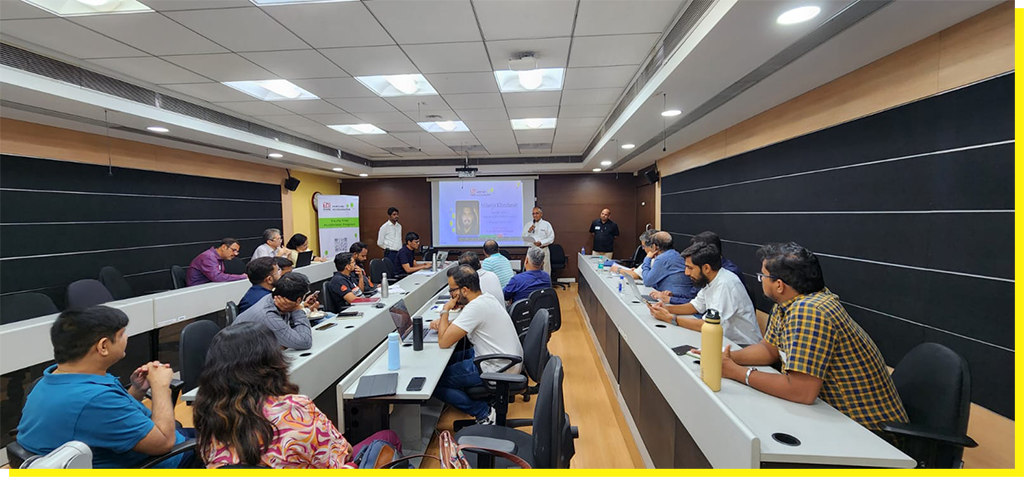
Not many people expect the Govt. to do much for the business community, much less the fledgling start-ups. But the truth is not so, according to Abhijeet Khandagle, TiE Nagpur CM. Abhijeet came down to Pune to let members know not just all the schemes that the Govt has for start-ups and more importantly, how to avail of these benefits.
“The Govt has several schemes specifically for the start-up community and there is a mandate for them to spend the specified amounts in a financial year” according to Abhijeet. Here is a brief lowdown on what these schemes are and how to avail them:
“It’s very important that every start-up registers itself with the DPIIT (MSME??)
Why?
If you supply any product or service to the Govt., then as a registered start-up you can raise an issue if your payment is delayed. If it is beyond a certain time limit, then you can be compensated up to 3 times even.
Services provided by MSME:
- Procurement and marketing support. This is especially beneficial to product manufacturers. The PSUs have a mandate to purchase a certain percentage from the MSME sector and a part of that has to be from women or SC/ ST owned companies. And the tragedy is that no PSU manages to fulfill this mandate.
- If you are a new product that is not listed then there is an agency that looks into such issues. Remember the Govt. wants to procure from small companies.
- Marketing Assistance: under this a start-up can get 80-90% reimbursed on expenses on stalls at trade exhibitions that you participate in. This is also applicable to international exhibitions. Yes, this process is slow but if you apply and it is approved you will get paid back.
This is valid for two events in a financial year. Please note that the Govt. must clear the funds available with it by the end of the financial year so they want to give you the money. It’s just that their processes are time consuming
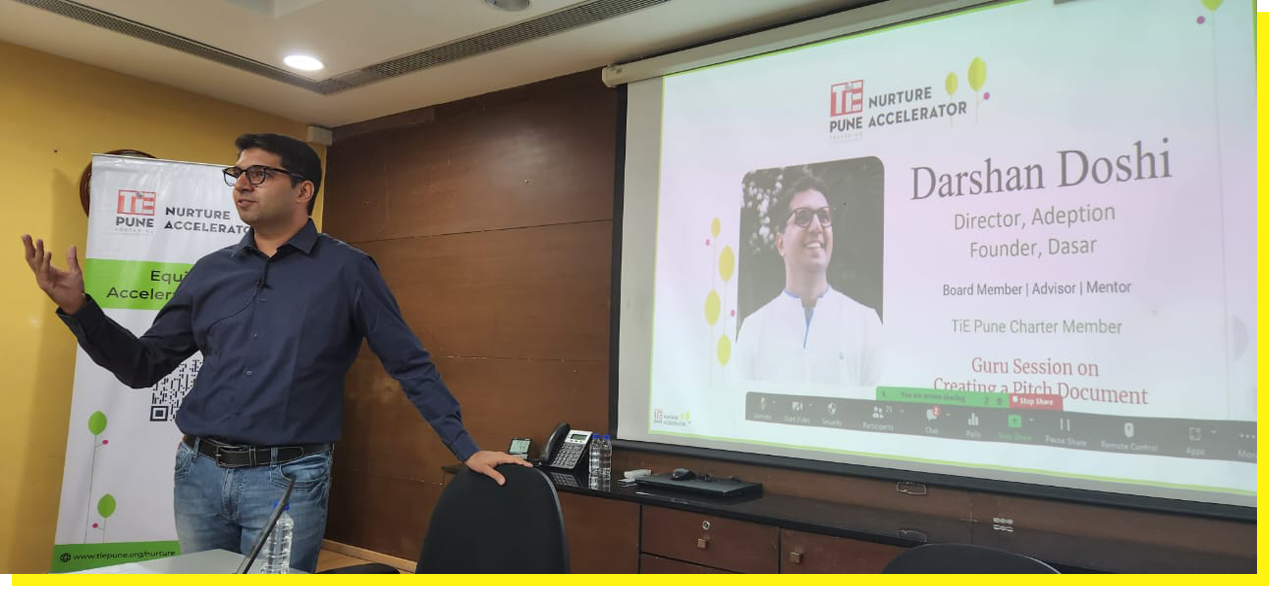
Credit Facilitation:
Most companies do not realize that debt is a much cheaper way to raise funds. And the Govt has many schemes available for MSMEs. In some cases, you can get up to 40% subsidy! And most loans are available on either a low interest rate or on simple interest. In some cases, there can be an interesting subvention too. It helps to have an account in a public sector bank. You could keep an operating account in a private bank and your capital account in a public sector bank. The District Industries Centre is the best place to get information on Govt schemes and benefits.
IP Registration:
The Govt reimburses 80% under its MSInS IP support scheme. And they are actively looking for companies to support. If your business is at an idea incubation stage. If your company is at this stage then the Business Incubation on MSME website. Once your product is ready and you are making some money, then it makes sense to go in for equity.
Contact us if you have a story to tell: rashmi.ghosh@tiepune.org

